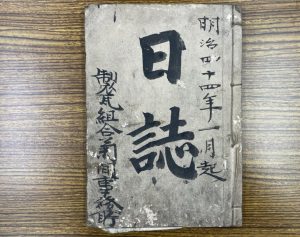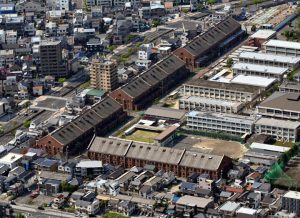Hiroshima Prefecture announces survey suggesting Yasushi Tamura — Army engineer who created important cultural property Konoe Division Headquarters — to be designer of Clothing Depot buildings
Oct. 25, 2022
Roof tiles of buildings made in Imabari, Ehime Prefecture
by Yo Kono, Staff Writer
The Imperial Japanese Army engineer Yasushi Tamura (1878–1942) was recently found to have possibly been a designer of the former Army Clothing Depot buildings, among the largest A-bombed structures and located in Hiroshima’s Minami Ward. On October 24, the Hiroshima Prefectural government reported the survey results to a review panel that had gathered at the prefectural government offices. The designer of the buildings had never before been identified. Mr. Tamura also designed the former Konoe Division Headquarters building, located in Tokyo, a structure that has been designated an important cultural property, among other buildings. The prefectural government considers the information to be an important element based on which the Clothing Depot buildings will be able to obtain an important cultural property designation.
When a prefectural government official examined old approval documents related to the Clothing Depot buildings stored at the National Institute for Defense Studies of Japan’s Ministry of Defense, in Tokyo, a stamp indicating the chief officer responsible for construction of the Clothing Depot buildings with the name “Tamura” appeared on the documents. Considering his involvement in the construction of numerous military facilities during the same time period, when he worked in the construction department of the accounting division of Japan’s Ministry of the Army, Mr. Tamura is now considered to be the possible designer of the Clothing Depot buildings.
After graduating from the Architecture Department at the Technical College of Tokyo Imperial University (now the Faculty of Engineering at the University of Tokyo), Mr. Tamura entered Japan’s Ministry of the Army. Later, he designed such Army buildings as the former Konoe Division Headquarters, which was later utilized as the National Crafts Museum in the National Museum of Modern Art, Tokyo, as well as an aircraft hangar at the Tokorozawa airfield, located in Tokorozawa City in Saitama Prefecture.
In addition, the roof tiles of the Clothing Depot buildings were found to be so-called ‘Kikuma-gawara’ tiles, produced in Imabari City in Ehime Prefecture. The tiles were engraved with a mark indicating “Kiku,” which led the Hiroshima Prefecture government to look into a ceramics cooperative association located in the area of Kikuma-cho in Imabari City. There, it ultimately found shipping records of roof tiles for the Clothing Depot buildings in an association journal compiled in 1911, two years prior to completion of the buildings. A majority of the original building roof tiles are estimated to date back to the time of completion of the buildings, since evidence of extensive renovation of the roofs has never been confirmed.
On the same day of the meeting, the prefectural government proposed construction methods to the review panel, including the idea of seismically reinforcing the buildings. In addition, about ten percent of the current roof tiles of adequate strength will be gathered and used for the roof of building No. 3, one of three of the buildings in possession of the prefecture. The roof tiles of the other buildings will be replaced with new tiles. The buildings’ steel doors that were bent by the A-bomb blast will be removed and stored inside the buildings, as 17 percent of the doors are severely corroded. The doors with minor damage will be kept in their current locations after being covered in nets as a safety precaution.
The review panel approved the construction proposal put forth by the prefecture. Osamu Goto, the panel chair and president of Kogakuin University who is a specialist in architectural history, said, “The Clothing Depot buildings’ value has increased simply because Mr. Tamura, an Army engineer of such stature, was involved. The buildings being designated a national important cultural property is now a real possibility.”
(Originally published on October 25, 2022)









